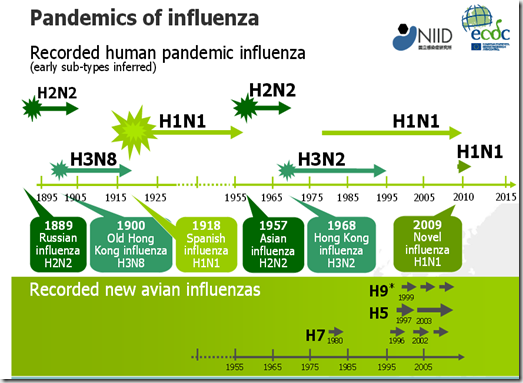Credit ECDC – 125 years of Pandemic History
# 10,465
The H3N8 subtype of influenza A is of particular interest to influenza researchers for several reasons.
- First, as the chart above illustrates, H3N8 is strongly suspected to have sparked human epidemics and a pandemic around the turn of the 20th century.
- Second, avian H3N8 remains endemic in birds.
- Third, about 50 years ago H3N8 jumped unexpectedly to horses in Miami, and since the 1970s appears to have supplanted the old equine H7N7 and is now the only equine-specific influenza circulating the globe.
- Fourth, in 2004 the equine H3N8 virus mutated enough to jump to canines, and began to spread among greyhounds in Florida (see EID Journal article Influenza A Virus (H3N8) in Dogs with Respiratory Disease, Florida).
- Fifth, in 2011 avian H3N8 was found in marine mammals (harbor seals), and 2012’s mBio: A Mammalian Adapted H3N8 In Seals, provided evidence that this virus had recently adapted to bind to alpha 2,6 receptor cells, the type found in the human upper respiratory tract.
- Sixth, the mBio findings were further confirmed last year in when Nature Communications: Respiratory Transmission of Avian H3N8 In Ferrets, confirmed that this `virus has an increased affinity for mammalian receptors, transmits via respiratory droplets in ferrets and replicates in human lung cells.’
Add in that in the short history of studying influenza, only H1, H2, and H3 subtypes have taken hold in the human population (see Are Influenza Pandemic Viruses Members Of An Exclusive Club?), and there are many who believe what went around 110 years ago could possibly come around again.
All of which makes the findings of the following study particularly interesting.
Cross-species infectivity of H3N8 influenza virus in an experimental infection in swine
J Virol. 2015 Aug 26. pii: JVI.01509-15. [Epub ahead of print]
Solórzano A1, Foni E2, Córdoba L3, Baratelli M3, Razzuoli E4, Bilato D5, Martín Del Burgo MÁ6, Perlin DS1, Martínez J7, Martínez-Orellana P3, Fraile L8, Chiapponi C2, Amadori M5, Del Real G6, Montoya M9
Abstract
Avian influenza A viruses have gained increasing attention due to their ability to cross the species barrier and cause severe disease in humans and other mammal species as pigs. H3 and particularly H3N8 viruses, are highly adaptive since they are found in multiple avian and mammal hosts. H3N8 viruses have not been isolated yet from humans; however a recent report showed that equine influenza A viruses (IAV) can be isolated from pigs, although an established infection has not been observed so far in this host.
To gain insight into the possibility of H3N8 avian IAV to cross the species barrier into pigs, in vitro experiments and an experimental infection in pigs with four H3N8 viruses from different origins (equine, canine, avian and seal) were performed. As positive control, a H3N2 swine influenza virus A was used. While equine and canine viruses hardly replicated in the respiratory apparatus of pigs, avian and seal viruses replicated substantially and caused detectable lesions in inoculated pigs without previous adaptation. Interestingly, antibodies against HA could not be detected after infection by hemaglutination inhibition test (HAI) with the avian and seal virus.
This phenomenon was observed not only in pigs but also in mice immunized with the same virus strains. Our data indicated that H3N8 IAV from wild aquatic birds have the potential to cross the species barrier and establish successful infections in pigs that might spread unnoticed using HAI as diagnostic tool.
IMPORTANCE SECTION:
Although natural infection of humans with an avian H3N8 influenza A virus has not yet been reported, this influenza A virus subtype has already crossed the species barrier. Therefore, we have examined the potential of H3N8 from canine, equine, avian and seal origin to productively infect pigs.
Our results demonstrated that avian and seal viruses replicated substantially and caused detectable lesions in inoculated pigs without previous adaptation. Surprisingly, we could not detect specific antibodies against HA in any H3N8-infected pigs. Therefore, special attention should be focused towards viruses of the H3N8 subtype as they could behave as stealth viruses in pigs.
While H3N8 doesn’t currently appear to be established in swine populations, for much of the world testing of pigs is rarely (if ever) done. In 2009 we did see evidence of H3N8 detected in Chinese swine in the middle of the last decade (see Isolation and molecular characterization of equine H3N8 influenza viruses from pigs in China).
For more background on this increasingly promiscuous virus, you may wish to revisit:
EID Journal: Equine H3N8 In Mongolian Bactrian Camel
Study: Dogs As Potential `Mixing Vessels’ For Influenza
